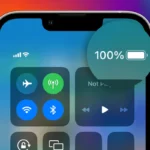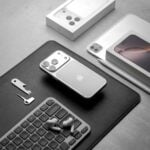Finding your iPad soaked with water can be a scary moment. Water and electronics don’t mix well, but acting fast might save your device from permanent damage. Taking quick action within the first few minutes after water exposure gives your iPad the best chance of survival.
Many people make mistakes when trying to fix a wet iPad. Don’t use rice – it can cause more harm with dust particles. Instead, immediately remove your iPad from the water and turn it off if it’s still on. Gently dry the outside with a soft cloth, and avoid pressing buttons or ports which could push water deeper inside.
For better drying results, you can place your iPad in a sealed bag with silica gel packets for 24-48 hours. This helps pull moisture from your device without adding dust. Wait at least two full days before trying to turn it on again to give it time to dry completely.
🔒 Prevention Tips
- Use a Waterproof Case
- Invest in a high-quality waterproof or water-resistant case if you often use your iPad near pools, kitchens, or outdoors.
- Keep It Away From Liquids
- Avoid placing drinks near your iPad. Even a small spill can seep into ports or the screen.
- Be Careful Outdoors
- If you’re using your iPad at the beach or in the rain, use a protective sleeve or bag.
- Store Safely
- Don’t leave your iPad in bathrooms, kitchens, or other humid environments where condensation can build up.
- Use Screen Protectors & Port Covers
- These won’t make your iPad waterproof, but they can reduce the chance of liquid seeping inside.
🚑 What to Do If Your iPad Gets Wet
- Turn It Off Immediately
- Don’t try to use it. Powering it on can short-circuit the device.
- Unplug Accessories
- Remove headphones, chargers, and any connected devices.
- Dry the Exterior
- Use a soft, absorbent cloth to wipe away visible water.
- Remove the Case & SIM Tray (if applicable)
- This helps moisture escape.
- Let It Air Dry
- Place the iPad in a dry, ventilated area. Avoid hair dryers or direct heat, which can damage components.
- Avoid Rice Myths
- Rice is not effective and can leave dust inside. Instead, use silica gel packets if available.
- Wait Before Restarting
- Give it at least 24–48 hours before attempting to power it back on.
🛠 Repair Options
- Apple Support
- AppleCare+ does not cover liquid damage, but you can get a replacement at a reduced cost if you have coverage.
- Authorized Repair Centers
- These can sometimes clean and repair water-damaged parts, though success depends on the extent of damage.
- Third-Party Repair Shops
- Cheaper than Apple, but results vary. Ensure they’re reputable and experienced with iPad water damage.
- Data Recovery Services
- If the iPad is beyond repair but data is critical, specialized services may retrieve files from the storage chip.
✅ Key Takeaways
- Prevention is the best protection: invest in a waterproof case and keep your iPad away from liquids.
- If water damage occurs, power off immediately and let it dry before attempting to restart.
- Repair options vary, but Apple and authorized providers offer the safest routes.
Key Takeaways
- Turn off your wet iPad right away and dry the outside with a soft cloth.
- Use silica gel packets instead of rice to draw out moisture from your device.
- Wait at least 48 hours before turning your iPad on to prevent electrical damage.
iPad Water Damage Repair Options Comparison
| Repair Option | Pros | Cons | Typical Cost Range* |
|---|---|---|---|
| Apple (Official Repair/Replacement) | – Guaranteed genuine parts – Professional service – Option for full replacement | – AppleCare+ doesn’t cover liquid damage – Can be very expensive if out of warranty | $300–$700+ (model dependent) |
| Authorized Repair Centers | – Trained technicians – May be cheaper than Apple – Some offer part-level repairs | – Still limited by Apple’s repair policies – Not always available in all regions | $200–$500 |
| Reputable Third-Party Shops | – Usually cheaper – Can attempt board-level cleaning/repairs – Faster turnaround | – Risk of non-genuine parts – Warranty may be voided – Success not guaranteed | $100–$300 |
| DIY (Do-It-Yourself) | – Lowest cost (just tools/materials) – Can be rewarding if successful | – High risk of further damage – Requires technical skills – No warranty or guarantee | $20–$80 (tools & supplies) |
| Data Recovery Services | – Can recover important files even if iPad is beyond repair | – Expensive – Device may remain unusable afterward | $300–$1000+ |
*Costs vary widely depending on iPad model, region, and severity of damage.
✅ Recommendation
- Mild exposure (small spill, quick action): Try drying first, then consider a third-party repair if issues persist.
- Severe exposure (fully submerged, won’t turn on): Apple or authorized repair is safest.
- Critical data needed: Consider professional data recovery if repair isn’t possible.
Understanding iPad Water Damage
Water damage can seriously harm your iPad. Liquid exposure affects different parts of the device in various ways, and Apple has built-in ways to detect if your iPad has been exposed to water.
Types of Liquid Exposure
iPads can face several kinds of liquid exposure. The most common is rain or splashes that might get on the screen or into ports. These small amounts can sometimes be fixed if handled quickly.
Full submersion, like dropping your iPad in a bathtub or toilet, causes more serious damage. The longer it stays underwater, the worse the damage will be.
Other harmful liquids include:
- Coffee, tea, or soda (contain sugar that creates sticky residue)
- Salt water (highly corrosive to metal parts)
- Chlorinated pool water (damages internal components)
Even high humidity or steam from a shower can slowly damage your iPad over time. This kind of exposure might not show immediate problems but can cause corrosion that spreads inside your device.
How Water Affects iPad Components
Water harms iPads in several major ways. First, it can create electrical shorts when liquid creates connections between parts that shouldn’t touch. This often happens instantly when water bridges electrical components.
The battery is especially vulnerable. Water contact may cause dangerous chemical reactions or even battery swelling. The logic board—your iPad’s brain—contains tiny components that quickly corrode when wet.
Your screen may show water spots, lines, or stop working after exposure. Touch functions often fail first. The charging port is another common damage point since it’s an opening to the inside.
Time makes water damage worse. Even after your iPad seems dry, internal corrosion spreads throughout the device. This hidden damage may cause parts to fail days or weeks later.
Liquid Contact Indicator (LCI)
Every iPad contains small Liquid Contact Indicators (LCIs). These are small dots or strips that change color when they touch liquid. They start white or silver but turn bright red after contact with water.
Apple technicians check these LCIs when you bring in a device. Their locations vary by iPad model but are typically found:
- In the SIM card tray area
- Inside headphone jacks (on older models)
- Within charging ports
The LCI is important because Apple uses it to determine if your device has water damage that voids the warranty. Regular warranties don’t cover liquid damage, though AppleCare plans do cover accidents including water exposure.
These indicators are designed to change color permanently. You cannot reset them once they’ve turned red, and trying to tamper with them may cause more damage to your device.
Preventive Measures
Protecting your iPad from water damage is much easier than dealing with the aftermath of an accident. The right accessories and careful habits can significantly reduce the risk of water exposure.
Protective Accessories
Waterproof cases offer the best defense against liquid damage. Look for cases with an IP68 rating, which provides high water resistance for your iPad. These cases seal all ports and buttons while still allowing full functionality.
Screen protectors with waterproof coatings add another layer of protection. They help prevent water from seeping into the screen edges where liquid can enter the device.
Port covers are inexpensive but effective. These small plugs fit into charging ports and headphone jacks to block water entry points.
Consider these additional accessories:
- Water-resistant tablet sleeves
- Silicone keyboard covers (for iPad keyboards)
- Dry bags for transport in rainy conditions
Best Practices in Water-Prone Environments
Keep your iPad away from water sources whenever possible. This means no using your tablet near pools, bathtubs, sinks, or at the beach where accidents happen easily.
Use stands to elevate your device when on tables. This simple habit prevents your iPad from sitting in spilled drinks or water puddles that might form on surfaces.
Be extra careful when using your iPad in the kitchen. Cooking areas combine multiple water risks with steam that can damage electronics over time.
Consider these safety habits:
- Never place drinks near your iPad
- Use your iPad with dry hands only
- Store your device in waterproof bags during travel
- Keep it away from bathroom counters and humid areas
Check weather forecasts before taking your iPad outdoors. Unexpected rain can quickly damage an unprotected device.
Immediate Actions After Water Exposure
When your iPad gets wet, quick action can save your device from permanent damage. The first few minutes are crucial, and knowing exactly what steps to take can make the difference between repair and replacement.
Powering Off and Disassembling
Turn off your iPad immediately after water exposure. Don’t test if it works or try to charge it. Press and hold the power button until the slide to power off option appears, then slide to shut down. If your iPad won’t respond, keep holding the power button for emergency shutdown.
Remove any accessories connected to your iPad. Unplug charging cables, disconnect headphones, and take off protective cases. These items can trap moisture against the device.
If you have a SIM card in your iPad, remove it and the tray. This helps create another pathway for water to escape from inside the device. Let the SIM card dry separately before reinserting it.
Remember that timing matters. The faster you power down your iPad after water exposure, the better its chances of survival.
Removing Excess Water
Gently dry the outside of your iPad with a soft, lint-free cloth. Pat the surface instead of wiping to avoid pushing water deeper into ports and openings.
Position your iPad at an angle that helps water drain out naturally. The charging port or speaker grills should face downward to let gravity help remove moisture.
Never use a hairdryer or other heat sources to dry your iPad. The heat can damage internal components and actually make water damage worse.
Consider using desiccants like silica gel packets to help absorb moisture. Place your iPad in a ziplock bag with desiccant packets and seal it, removing as much air as possible. Leave it in a warm, dry place for at least 48-72 hours.
Avoiding Common Mistakes
Don’t shake or tilt your iPad vigorously. This can spread the liquid to previously unaffected areas inside your device. Gentle positioning is key.
Resist the urge to turn on your iPad too soon. Wait at least 48-72 hours before attempting to power it on, even if the outside seems completely dry.
Never put your iPad in rice. This popular myth can actually cause more harm than good. Rice dust can get inside your device and cause additional damage to sensitive components.
Avoid pressing buttons repeatedly or plugging in your iPad to “test” if it works. This can short-circuit the device if water is still present inside.
If your iPad was exposed to salt water, soda, or other liquids besides plain water, consider rinsing it with distilled water first. Salt and sugar can cause corrosion and sticky residue that’s more damaging than plain water.
Professional Assessment and Repair
When your iPad suffers water damage, professional repair services offer the expertise and tools needed to properly diagnose and fix the problem. Certified technicians can often save devices that might otherwise be considered lost.
Finding a Certified Technician
Water damage requires immediate professional attention from qualified experts. Look for Apple Independent Repair Providers who are specially trained to work on iPads. These technicians have access to proper tools and genuine parts.
Apple Support provides official iPad repair services with technicians who understand the complex internal components of your device. Many local repair shops like uBreakiFix and CPR Cell Phone Repair also offer specialized iPad water damage services.
Always check reviews and certifications before choosing a repair shop. Ask about their experience with water-damaged iPads specifically. Good technicians will be honest about the chances of recovery and potential issues.
Understanding the Repair Process
The iPad water damage repair process follows several important steps:
- Assessment – Technicians will open your device to check the extent of damage
- Component drying – Professional-grade equipment removes moisture
- Cleaning – Special solutions remove corrosion and mineral deposits
- Testing – Each component is tested for functionality
- Replacement – Damaged parts are swapped with working ones
Repair specialists will open your iPad, dry internal components, and rinse away debris. They use microscopes to spot tiny signs of corrosion that might cause future problems.
The process typically takes 3-5 days for thorough drying and testing. Some shops offer rush services at higher rates.
Costs and Warranty Considerations
Water damage repair costs vary based on:
| Repair Factor | Price Impact |
|---|---|
| iPad model | Newer = Higher cost |
| Damage extent | More damage = Higher cost |
| Needed parts | More replacements = Higher cost |
Basic water damage service starts around $100-150 but can reach $400+ for extensive repairs. Specialized iPad Air water damage repair may have different pricing.
Standard Apple warranties don’t cover water damage. AppleCare+ includes limited accidental damage protection with a service fee. Third-party repair shops often offer their own 30-90 day warranties on repairs.
Always get a written estimate before approving work. Ask about warranty terms for both parts and labor. Some shops guarantee against future corrosion issues from the same water damage incident.
Data Recovery and Backup Solutions
When your iPad gets water damaged, having a backup or knowing how to recover your data can save you from losing important files. Both preventive measures and recovery options are important to understand.
Backup Strategies Before Damage Occurs
The best defense against water damage is having regular backups in place. Apple offers two main backup methods for iPads: iCloud and iTunes/Finder.
iCloud backup happens automatically when your iPad is:
- Connected to Wi-Fi
- Plugged in to power
- Screen locked
- Connected to iCloud with enough storage
To check if iCloud backup is on, go to Settings > [your name] > iCloud > iCloud Backup. Turn it on if needed.
iTunes/Finder backups offer a local option. Connect your iPad to a computer and use iTunes (Windows) or Finder (Mac) to create a full backup. These backups store everything on your device, unlike iCloud which may skip some data.
Third-party apps like Google Drive or Dropbox can back up specific files too. Many art apps also have their own cloud storage options.
Data Recovery Techniques
If your iPad suffers water damage, don’t turn it on immediately. This could cause short circuits and more damage to your device.
Professional data recovery services can help retrieve data from water-damaged iPads. Companies like DriveSavers specialize in recovering data from damaged devices and have been doing so since 1985.
Apple does not offer data recovery for water-damaged devices, so third-party services are your only option in severe cases.
If you have iTunes or iCloud backups, you can restore your data to a new iPad. Programs like FoneLab and TunesKit can help extract data from backups even if your device is unusable.
For artists, check if your art apps stored your work in the cloud before the damage occurred.
Technical Considerations for Water-Damaged iPads
Water damage to iPads affects multiple internal parts that may not show immediate signs of failure. The extent of damage depends on water type, exposure time, and how quickly proper drying steps were taken.
Assessing Internal Component Damage
When an iPad gets wet, several critical components face risk. The motherboard, which houses sensitive circuits, often shows the first signs of damage. Water can create electrical shorts between connection points that weren’t meant to touch.
Battery damage is particularly concerning as moisture can trigger chemical reactions inside. This might lead to swelling or reduced capacity over time. Remove any accessories from your iPad immediately after water contact.
The display assembly may develop cloudy spots or lines where water has penetrated between layers. Touch sensitivity issues often indicate water damage to the digitizer components.
Connection ports deserve special attention. Charging problems typically point to corroded lightning port contacts. Headphone jacks and speaker grilles can trap moisture even after the device seems dry outside.
Corrosion and Long-Term Effects
Corrosion represents the most dangerous long-term threat to water-damaged iPads. Even after proper drying, microscopic water droplets can remain inside. These cause metal components to oxidize over weeks or months.
Green or white deposits on circuit boards signal active corrosion. This process continues silently, slowly degrading connections until complete failure occurs. Turning off your iPad for at least 24 hours after water exposure helps minimize this risk.
Water damage often creates delayed failures. An iPad might work properly at first but develop problems weeks later as corrosion spreads. Battery life typically decreases gradually as internal components degrade.
Salt water causes much faster corrosion than fresh water due to its higher conductivity. Chlorinated pool water similarly accelerates damage to metal parts. Acting quickly to remove the iPad from water helps limit potential long-term damage.
Prevention and Care for Future Incidents
Protecting your iPad from water damage requires both preventive measures and proper maintenance habits. Taking simple steps now can save you from costly repairs later.
Routine Maintenance Tips
Keep your iPad in a high-quality protective case that offers water resistance. Many cases provide basic protection against splashes and light rain. Clean charging ports regularly with a soft, dry brush to remove dust and lint that could trap moisture.
Always keep liquids away from your device during use. A simple spill-proof stand can help prevent accidents when using your iPad near drinks. When traveling, store your iPad in a waterproof bag, especially in humid environments or near water.
Check your device’s seals and port covers periodically for signs of wear. Damaged seals can let water in more easily. This same advice applies to other devices like iPhones and Android smartphones.
Using Environmental Controls
Control the humidity in spaces where you use and store your iPad. Excessive moisture in the air can slowly damage electronic components over time. A dehumidifier in humid areas can help protect all your consumer electronics.
Avoid rapid temperature changes, which can create condensation inside your device. Don’t move your iPad directly from very cold to warm environments without allowing it to adjust gradually.
Consider using silica gel packets in your iPad storage area or case. These desiccants absorb moisture and help keep your device dry. Replace them regularly for best results.
When at the beach or pool, keep your iPad in a sealed container when not in use. The combination of water, sand, and salt creates a particularly damaging environment for all electronics.
Resource and Support Availability
When dealing with iPad water damage, knowing where to turn for help is crucial. Different support options exist, from Apple’s official services to third-party protection plans that can save you money and stress.
Manufacturer Support Services
Apple offers limited options for water-damaged iPads. The standard Apple One-Year Limited Warranty does not cover liquid damage to devices. This means if your iPad stops working after contact with water, you’ll likely need to pay for repairs.
For immediate help, Apple Support can guide you through basic troubleshooting. You can contact them through:
- Phone support
- Online chat
- Genius Bar appointments at Apple Stores
If your iPad needs professional attention, Apple may offer out-of-warranty service. The cost varies based on the model and damage level, typically ranging from $99-$599.
Some Apple technicians might suggest a DIY first-aid approach for minor water exposure. This includes turning off the device immediately and placing it in a ziplock bag with desiccant in a warm, dry place for several days.
Insurance and Protection Plans
Several insurance options can protect your iPad from water damage expenses:
AppleCare+: This extended warranty covers two incidents of accidental damage for a $49 service fee per incident. It’s available for purchase within 60 days of buying your iPad.
Carrier Insurance: If you bought a cellular iPad through a mobile carrier, they might offer protection plans covering water damage.
Third-Party Repair Services: Companies like CPR (Cell Phone Repair) specialize in fixing water-damaged tablets. They’re often local and cheaper than Apple’s service.
Credit Card Benefits: Some premium credit cards extend warranty coverage or provide purchase protection that might help with water damage costs.
Homeowner’s or renter’s insurance sometimes covers electronics, but deductibles are often high, making claims impractical for single devices.
Frequently Asked Questions
iPad water damage can lead to various issues from simple malfunctions to complete device failure. Here are answers to common questions about diagnosing, repairing, and handling water-damaged iPads.
How can I tell if my iPad has water damage?
Look for moisture under the screen, which often appears as foggy areas or water droplets visible beneath the glass. This is one of the most obvious signs.
Check the Liquid Contact Indicator (LCI), which is located in the SIM card tray area on cellular models. If it’s red instead of white or silver, your iPad has contacted liquid.
Test all buttons and functions. Water damage often affects the home button, volume controls, or makes the touchscreen unresponsive in certain areas.
What are the common indicators of water damage in an iPad?
Erratic behavior such as apps opening randomly or the screen registering phantom touches often indicates water damage. These symptoms may appear immediately or develop days after exposure.
Battery issues, including rapid drainage or inability to hold a charge, commonly occur after liquid exposure. Your iPad might also overheat more quickly than normal.
Corrosion inside the charging port is another telltale sign. You might notice green or white crusty buildup, or experience charging problems even with a working cable.
What is the average repair cost for a water-damaged iPad?
Professional repair costs typically range from $150 to $400 depending on the model and extent of damage. Newer models like the iPad Pro tend to be at the higher end of this range.
Apple’s service fee for water damage repair generally falls under their “other damage” category, which is often comparable to their out-of-warranty replacement cost.
Independent repair shops might offer more competitive pricing, sometimes 20-40% less than Apple’s official service centers.
Is it possible to fix an iPad that won’t turn on due to water damage?
Yes, an iPad that won’t turn on after water exposure can sometimes be repaired by professional technicians. Success depends on how quickly you addressed the initial damage and its severity.
Never attempt to charge or turn on a wet iPad, as this can cause further damage to the circuitry. The device should be completely dry before any power is applied.
Data recovery is often possible even if the iPad cannot be repaired, though this service typically costs extra.
Are iPads covered for water damage under Apple’s warranty policy?
No, standard Apple warranties and AppleCare+ do not cover water damage as it falls under accidental damage. The warranty specifically excludes liquid contact.
AppleCare+ does offer coverage for up to two incidents of accidental damage, including water damage, but a service fee of $49 applies for each repair.
You can check your coverage status by entering your iPad’s serial number on Apple’s support website or calling Apple Support directly.
Where can I locate a service center for water-damaged iPad repairs?
Apple Stores and Apple Authorized Service Providers are official options for water damage repair. You can find nearby locations through Apple’s website or by calling their support line.
Independent repair shops specializing in Apple products can often fix water-damaged devices at lower costs. Look for shops with good reviews and experience with liquid damage specifically.
Some major electronics retailers like Best Buy also offer iPad repair services through their Geek Squad department, with locations throughout most major cities.







